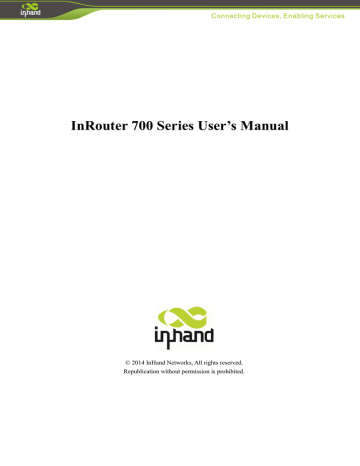advertisement

I
Introduction to InRouter 700 Series
◆
Overview
◆
Product Models
◆
Product Features & Specifications
◆
Package Checklist
1.1 Overview
InRouter 700 series industrial grade routers provide users with stable and high speed connection between remote devices and customer’s center via 2.5G/3G networks. They allow wide voltage power supply (9-48V DC), large range operating temperature from -25°C to 70°C (-10 ~ 158F)/ humidity: 95% RH, and fully satisfy various EMC verifications, which ensure stability and reliability under harsh industrial conditions. The InRouter 700 can be placed on a desktop or
DIN-mounted.
InRouter 700 series products support VPN (IPSec/PPTP/ L2TP/GRE/SSL VPN), which create high-security links between remote equipment and customer’s center.
In Addition, InRouter 700 series products support the Device Manager remote device manage platform, which realizes remote operation including remote control, remote monitor, parameters configure, firmware upgrade, log/alarm management, information statistics/display, batch configuration/update and etc.
Important Safety Information
This product is not intended for use in the following circumstances
Area(s) where radio transmission equipment (such as cell phone) are not permitted.
Hospitals, health care facilities and area(s) where cell phones are restricted by law.
Gas stations, fuel storage and places where chemical are stored.
Chemical plants or places with potential explosion hazard.
Any metal surface that may weaken the radio signal level.
RF safety distance
For GPRS router, the compliance boundary distance is r=0.26m for GSM 900MHz and r=0.13m for DCS 1800 MHz.
For HSUPA router, the compliance boundary distance is r=0.26m for GSM 900MHz and
r=0.13m for DCS 1800 MHz, r=.0.094 for WCDMA 900MHz, r=0.063 for WCDMA 2100MHz.
Warning
This is a class A product. In a domestic environment this product may cause radio interference in which case the user may be required to take adequate measures.
WEEE Notice
The Directive on Waste Electrical and Electronic Equipment (WEEE), which entered into force as European law on
13th February 2003, resulted in a major change in the treatment of electrical equipment at end-of-life.
The purpose of this Directive is, as a first priority, the prevention of WEEE, and in addition, to promote the reuse, recycling and other forms of recovery of such wastes so as to reduce disposal.
The WEEE logo (shown at the left) on the product or on its box indicates that this product must not be disposed of or dumped with your other household waste. You are liable to dispose of all your electronic or electrical waste equipment by relocating over to the specified collection point for recycling of such hazardous waste. Isolated collection and proper recovery of your electronic and electrical waste equipment at the time of disposal will allow us to help conserving natural resources. Moreover, proper recycling of the electronic and electrical waste equipment will ensure safety of human health and environment.
For more information about electronic and electrical waste equipment disposal, recovery, and collection points, please contact your local city centre, household waste disposal service, shop from where you purchased the equipment, or manufacturer of the equipment.
advertisement
* Your assessment is very important for improving the workof artificial intelligence, which forms the content of this project
Related manuals
advertisement
Table of contents
- 4 Introduction to InRouter 700 Series
- 4 Overview
- 7 Package Checklist
- 8 Product Features
- 8 1.3.1 Interfaces
- 9 1.3.2 Functions
- 10 1.3.3 Environmental Limits
- 10 1.3.4 Power Requirements
- 10 1.3.5 Physical Characteristics
- 10 1.3.6 Advanced Industrial Features
- 11 1.3.7 Device Management Software
- 11 1.3.8 Warranty
- 12 Product Models
- 13 Quick Installation Guide
- 14 Typical Application
- 14 Panel Layout
- 16 Quick Connection to Internet
- 16 2.3.1 Insert SIM Card
- 16 2.3.2 Antenna Installation
- 16 2.3.3 Power Supply
- 16 2.3.4 Connect
- 17 2.3.5 Build Connection between InRouter and your PC
- 19 2.3.6 Start to configure your InRouter 700(Optional)
- 20 2.3.7 Connect InRouter with Internet
- 21 Quick IPSec VPN Configuration
- 23 Reset to Factory Defaults
- 23 Hardware Approach
- 24 2.5.2 Web Approach
- 25 Advanced Configuration
- 25 Configuration on Web
- 25 3.1.1 Preparation
- 27 3.1.2 System
- 31 3.1.3 Network
- 41 3.1.4 Service
- 45 3.1.5 Firewall
- 47 3.1.6 QoS
- 47 3.1.7 VPN(For IR79x only)
- 55 3.1.8 Tools
- 56 3.1.9 Status
- 59 CLI Configuration
- 59 4.1 CLI Operation
- 61 4.2 CLI command